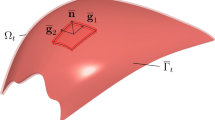Abstract
This paper proposes a new 9-node degenerated shell element based on a nonlinear mixed formulation. To avoid locking phenomena, we present a mixed formulation based on a three-field Hu-Washizu principle in which displacements, the Green strain tensors, and the second Piola-Kirchhoff stress tensors are independently assumed. In approximating strain and stress fields, covariant components of the strains and stresses measured in the element curvilinear coordinate system are interpolated by the common polynomial functions over an element. Parameter vectors of stress and strain interpolants are elementwise eliminated so that we may obtain an element stiffness matrix similar to that of the displacement model. This formulation is mathematically clear in the variational context, and can include geometrical and material nonlinearities without spoiling such clearness. Numerical results based on our approach are illustrated with satisfactory behavior of the element observed.
Similar content being viewed by others
References
Bathe, K. J.; Dvorkin, E. N. (1986): A formulation of general shell elements—the use of mixed interpolation of tensorial components. Comput. Methods Appl. Mech. Eng. 22, 697–722
Belytschko, T.; Stolarski, H.; Liu, W. K.; Carpenter, N.; Ong, J. S. J. (1985): Stress projection for membrane and shear locking in shell finite elements. Comput. Methods Appl. Mech. Eng. 51, 221–258
Horrigmoe, G.; Bergan, P. G. (1978): Nonlinear analysis of free-form shells by flat finite elements. Comput. Methods Appl. Mech. Eng. 16, 11–35
Huang, H. C.; Hinton, E. (1986): A new none node degenerated shell element with enhanced membrane and shear interpolation. Int. J. Numer. Methods Eng. 22, 73–92
Hughes, T. J. R.; Liu, W. K. (1981): Nonlinear finite element analysis of shells—Part 1. Three dimensional shells. Comput. Methods Appl. Mech. Eng. 26, 331–362
Javaherian, H.; Dowling, P. J. (1985): Large deflection elastoplastic analysis of thin shells. Eng. Struct. 7, 154–163
Lee, S. W.; Wong, S. C.; Rhiu, J. J. (1985): Study of a nine-node mixed formulation finite element for thin plates and shell. Comput. Struct. 21, 1325–1334
Liu, W. K.; Law, E. S.; Lam, D.; Belytschko, T. (1985): Resultant-stress degenerated-shell element. Comput. Methods Appl. Mech. Eng. 55, 259–300
MacNeal, R. H.; Harder, R. L. (1985): A proposed standard set of problems to test finite element. Finite Elem. Anal. Des. 1, 3–20
Owen, D. J. R.; Figueiras, J. A. (1983): Elasto-plastic analysis of anisotropic plates and shells by the semiloof element. Int. J. Numer. Methods Eng. 19, 521–539
Parisch, H. (1978): A critical survey of the 9-node degenerated shell element with special emphasis on thin shell applications and reduced integration. Comput. Methods Appl. Mech. Eng. 20, 323–350
Park, K. C.; Stanley, G. M. (1986): A curved C 0 shell element based on assurmed natural-coordinate strains. J. Appl. Mech. 53, 278–290
Ramm, E. (1982): The Riks/Wempner approach—an extension of the displacement control method in nonlinear analysis. In: Taylor, R. L. (ed.). Recent advances in nonlinear computational mechanics, pp. 63–86. Swansea: Pineridge Press
Salleb, A. F.; Chang, T. Y.; Graf, W. (1987): A quadrilateral shell element using a mixed formulation. Comput. Struct. 26, 787–803
Simo, J. C.; Hughes, T. J. R. (1987): On the variational foundations of assumed strain methods. J. Appl. Mech. 53, 51–54
Simo, J. C.; Ortiz, M. (1985): A unified approach finite deformation elastoplastic analysis based on hyperelastic constitutive equations. Comput. Methods Appl. Mech. Eng. 49, 221–245
Simo, J. C.; Taylor, R. L.; Pister, K. S. (1985): Variational and projection methods for the volume constraint in finite deformation elasto-plasticity. Comput. Methods Appl. Mech. Eng. 51, 177–208
Timoshenko, S P.; Krieger, W. K. (1959): Theory of plates and shells, 2nd edn. New York: McGraw-Hill
Xue, W. M.; Karlovitz, L. A.; Atluri, S. N. (1985): On the existence and stability conditions for mixed-hybrid finite element solutions based on Reissner's variational principle. Int. J. Solids Struct. 21, 97–116
Yamada, T.; Wada, A.; Kikuchi, F. (1989): Control of spurious modes in a 9-node shell element based on the assumed strain approach. Theor. Appl. Mech. 38, 81–91
Author information
Authors and Affiliations
Additional information
Communicated by G. Yagawa, March 8, 1990
Rights and permissions
About this article
Cite this article
Yamada, T., Kikuchi, F. & Wada, A. A 9-node mixed shell element based on the Hu-Washizu principle. Computational Mechanics 7, 149–171 (1991). https://doi.org/10.1007/BF00369976
Issue Date:
DOI: https://doi.org/10.1007/BF00369976




